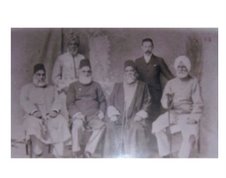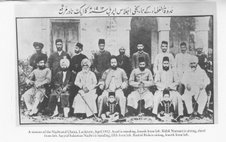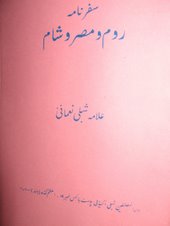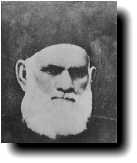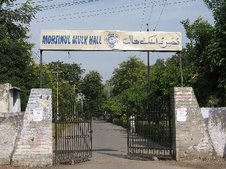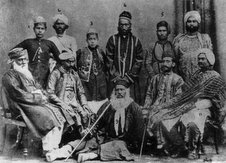Allama Shibli Nomani
Muhammad Shibli Nomani
Born on June 3, 1857 in Bindawal Azamgarh (UP)
Died on 18th November 1914 in Azamgarh (UP)
Father : Shaikh Habibullah
Born on June 3, 1857 in Bindawal Azamgarh (UP)
Died on 18th November 1914 in Azamgarh (UP)
Father : Shaikh Habibullah
Mother : Moqeema Khatoon (d/o Mr.Qurban Ahmad, Phariha Azamgarh)
Wife : Majidunnisa (Married 1876-77)
Brothers : Mahdi Hasan (MAO College Student)
Mohammad Ishaq, Mohammad Junaid, Mohammad
Children : Hamid Hassan Nomani , Rabia Khatoon , Jannutul Fatima
Children : Hamid Hassan Nomani , Rabia Khatoon , Jannutul Fatima
Teachers: Maulana Farooq Chirayyakuti, Chirayyakot Azamgarh
Maulana Irshad Husain, Rampur,
Maulana Faiz ul Hasan Saharanpuri, Lahore,
Maulana Ahmad Ali Saharanpuri
MAO College Association: 1882 - 1898
Professor of Persian and Arabic
Founder Editor of The Aligarh Magazine (Urdu)-1891
Famous Students:
Famous Students:
Hamid ud din Farahi, Abul Kalam Azad, Saiyid Sulaiman Nadvi, Muhammad Ali Jauhar, Zafar Ali Khan, Sajjad Haider Yaldram, Aziz Mirza, Masud Ali Mahvi, Abdus Salam Nadvi, Abdul Bari Nadvi, Shibli Mutakallim Nadvi
Books :
Seerat-un-Nabi – 7 Volumes (co-edited by Syed Sulaiman Nadvi)
Muqadmat-Seeratun Nabi
Al-Farooq : Biography of Hazrat Omar Farooq (R.A.)
Al-Ghazali : Biography of Imam Ghazali (R.A.)
Al-Mamoon : Biography of Khalifa Mamoon Rashid
Seerat-un-Noman : Biography of Imam Abu Hanifa
Swaneh-Maulana Roomi
Al-Kalam
Ilmul-Kalam
Safar Nama Room-Misr-o-Shaam
Sherul-Ajam -5 Volumes
Kuliyat-e-Shibli (Urdu)
Kuliyat-e-Shibli (Farsi)
Mawazenah Anees-o-Dabeer
Al-Inteqar
Auragzeb Alamgeer per Ek Nazar
Muhammad Shibli Nomani (1857-1914) more popularly known as Shibli Nomani or even simply as Shibli was born in a respected family of landed aristocracy in Bindawal, a village of Azamgarh district in eastern U.P. in 1857. Thus Shibli was born while the first war of independence was at its peak. Azamgarh and surrounding areas were particularly affected by its patriotic fervour. It was a matter of symbolic significance that on the day of his birth the freedom fighters broke open the gates of district jail and set free the prisoners incarcerated there. He took his first breaths in this highly surcharged patriotic and rebellious atmosphere. It was bound to have an abiding influence on the thinking and attitudes of Shibli in the days to come. He had imbibed the indomitable spirit of independence in his cradle and it remained with him as a distinctive trait of his personality throughout his life.
Shibli occupies a very important place in the history of Muslim community in modern India. His role in revitalizing and reviving the community is enormous. By his scholarly and intellectual attainments, he revived the memories of the great scholars of our past. He was an accomplished scholar of Islamic sciences and Arabic and Persian languages and literature. He was a prolific writer of Urdu both in prose and poetry. He was a prose writer of great excellence who remains unrivalled for the literary elegance and beauty of his writings. His poetry, both in Persian and Urdu, was of a very high order and excellence. He is considered as the last great poet of Persian in India. His historical writings opened new vistas and touched unprecedented heights of scholarly depth, incisive interpretation, deep insight, penetrating criticism and refreshing approach. It earned for him the title of the first teacher of history of the Indian Muslims, an honour that he thoroughly deserved. By his powerful writings he not only defended Islam against the ideological onslaught of the orientalists but eminently succeeded in creating a deep and abiding sense of pride, attachment and belonging with the past among the Indian Muslims. His personality was multifaceted and his contributions are immense and multidimensional. The people whom he taught, trained and influenced are legion and the exact nature and magnitude of their contribution in the fields of their interest is difficult to assess. Among them are included such illustrious personalities as Hamid ud din Farahi, Abul Kalam Azad, Saiyid Sulaiman Nadvi, Muhammad Ali Jauhar, Zafar Ali Khan, Sajjad Haider Yaldram, Aziz Mirza, Masud Ali Mahvi, Abdus Salam Nadvi, Abdul Bari Nadvi to name only a few. He built many institutions that continue to play a vital role in the life of the community. Darul Musannifin Shibli Academy had no parallel in the Sub Continent as a centre of historical research and publication. He was an Alim, scholar, educationist, reformer, historian, litterateur and much more. It is, therefore, not possible to attempt even a brief survey of his varied accomplishments and contributions in a small article. The endeavour here therefore would be confined to a brief study of his association with Aligarh and the contribution that he made to the Aligarh Movement.
Shibli and Aligarh Movement
Muqadmat-Seeratun Nabi
Al-Farooq : Biography of Hazrat Omar Farooq (R.A.)
Al-Ghazali : Biography of Imam Ghazali (R.A.)
Al-Mamoon : Biography of Khalifa Mamoon Rashid
Seerat-un-Noman : Biography of Imam Abu Hanifa
Swaneh-Maulana Roomi
Al-Kalam
Ilmul-Kalam
Safar Nama Room-Misr-o-Shaam
Sherul-Ajam -5 Volumes
Kuliyat-e-Shibli (Urdu)
Kuliyat-e-Shibli (Farsi)
Mawazenah Anees-o-Dabeer
Al-Inteqar
Auragzeb Alamgeer per Ek Nazar
Muhammad Shibli Nomani (1857-1914) more popularly known as Shibli Nomani or even simply as Shibli was born in a respected family of landed aristocracy in Bindawal, a village of Azamgarh district in eastern U.P. in 1857. Thus Shibli was born while the first war of independence was at its peak. Azamgarh and surrounding areas were particularly affected by its patriotic fervour. It was a matter of symbolic significance that on the day of his birth the freedom fighters broke open the gates of district jail and set free the prisoners incarcerated there. He took his first breaths in this highly surcharged patriotic and rebellious atmosphere. It was bound to have an abiding influence on the thinking and attitudes of Shibli in the days to come. He had imbibed the indomitable spirit of independence in his cradle and it remained with him as a distinctive trait of his personality throughout his life.
Shibli occupies a very important place in the history of Muslim community in modern India. His role in revitalizing and reviving the community is enormous. By his scholarly and intellectual attainments, he revived the memories of the great scholars of our past. He was an accomplished scholar of Islamic sciences and Arabic and Persian languages and literature. He was a prolific writer of Urdu both in prose and poetry. He was a prose writer of great excellence who remains unrivalled for the literary elegance and beauty of his writings. His poetry, both in Persian and Urdu, was of a very high order and excellence. He is considered as the last great poet of Persian in India. His historical writings opened new vistas and touched unprecedented heights of scholarly depth, incisive interpretation, deep insight, penetrating criticism and refreshing approach. It earned for him the title of the first teacher of history of the Indian Muslims, an honour that he thoroughly deserved. By his powerful writings he not only defended Islam against the ideological onslaught of the orientalists but eminently succeeded in creating a deep and abiding sense of pride, attachment and belonging with the past among the Indian Muslims. His personality was multifaceted and his contributions are immense and multidimensional. The people whom he taught, trained and influenced are legion and the exact nature and magnitude of their contribution in the fields of their interest is difficult to assess. Among them are included such illustrious personalities as Hamid ud din Farahi, Abul Kalam Azad, Saiyid Sulaiman Nadvi, Muhammad Ali Jauhar, Zafar Ali Khan, Sajjad Haider Yaldram, Aziz Mirza, Masud Ali Mahvi, Abdus Salam Nadvi, Abdul Bari Nadvi to name only a few. He built many institutions that continue to play a vital role in the life of the community. Darul Musannifin Shibli Academy had no parallel in the Sub Continent as a centre of historical research and publication. He was an Alim, scholar, educationist, reformer, historian, litterateur and much more. It is, therefore, not possible to attempt even a brief survey of his varied accomplishments and contributions in a small article. The endeavour here therefore would be confined to a brief study of his association with Aligarh and the contribution that he made to the Aligarh Movement.
Shibli and Aligarh Movement
1881 proved to be a turning point in his life. In that year he went to Aligarh along with his father to pay a visit to his younger brother, Mahdi Hasan, who was a student at M. A. O. College. In this journey he also met Sir Syed, a meeting that was destined to change his life and give it a new purpose, meaning and direction. In accordance with the traditions of the time he presented an Arabic Qasida (Ode) in praise of Sir Syed. Contrary to the style of those days, it was composed in the style of classical Arabic poetry. Sir Syed was impressed by it as he could see through it the great creative genius of the writer. He published it in Aligarh Gazette with a note of appreciation. This paved the way for Shibli’s eventual appointment at Aligarh. A new star of matchless brightness was to impart its lustre to the intellectual firmament of Aligarh and the conditions for this were created on this occasion.
In 1882 there was a vacancy for a teacher to teach Arabic and Persian languages in the College. Towards the end of January Shibli was appointed as Professor of Persian and Assistant Professor of Arabic. He joined his duty on 1st of February 1882. He spent next sixteen years at Aligarh. Initially his salary was fixed at Rs. Forty a month. Shibli belonged to a well to do family. He seems to have felt deeply hurt at this paltry salary. But he also seems to have realised the immense possibilities that Aligarh offered to the growth of his intellectual faculties and attainment of academic excellence. He settled for the later. There could not have been a better bargain. Later in 1886, he was promoted as Professor of Arabic as well and his salary was also raised accordingly. Ultimately it rose to Rs. 100 per month. But the extremely vital role that he was destined to play in the uplift of the College, furtherance of the objectives of the Aligarh Movement and enlightenment of the Muslim community of the Subcontinent could not be determined and understood in terms of salaries and stipends.
The most important thing that Shibli acquired at Aligarh was his abiding concern for the plight of the community and realization of the imperative need to work for its uplift and taking it out of the morass in which it found itself. It was a natural outcome of his contact with Sir Syed. It provided a direction to him and gave him a purpose and objective to work for. It fired his imagination and opened up new horizons before his eyes. This concern remained with him throughout his life. At Aligarh he came into contact with European scholars. He developed very close and friendly relations with Professor T. W. Arnold and learnt from him modern methods of research and scholarship, which he put to maximum use in putting across his own views and researches. He learnt French from him and taught him Arabic. He has referred to him as a friend and a mentor. It was here that he had access to the works of the orientalists and became painfully conscious of the great need to do something to resist and stop their onslaught against Islam and the Muslims and it determined the course of his future academic activities. He was a voracious reader and at Aligarh he had access to a virtual treasure of rare books to satisfy his thirst. Sir Syed’s library was perhaps the best library of its kind during those days in the entire subcontinent. It had an excellent collection of Arabic and Persian books of great Muslim scholars, which were being published in Europe and which, according to Shibli himself, were still beyond the reach of scholars even in Egypt. Seeing Shibli’s interest in scholarly pursuits, Sir Syed had allowed him free access to his library. This opened up new vistas of research and scholarship before him. The results of his researches delighted and amazed even great scholars. Sir Syed was deeply impressed by his scholarship and began to rely more and more on him in his researches. He built a banglow for him near his residence so that he could have easy access to his library. They spent much time together discussing scholarly subjects of mutual interest. Shibli had a very high opinion about Sir Syed’s great qualities of mind and heart. This mutual respect and appreciation for each other found expression on many occasions and forms a shining chapter of Aligarh’s history.
The contribution of Shibli to the Aligarh movement and his services in furthering its cause are varied and many. First of all he was a committed and dedicated teacher and was fully alive to his responsibility towards educating and building the character of his students and molding their views. His erudition, scholarship, vast knowledge of Islam and Islamic history and his ability to effectively communicate with them enabled him to establish effective rapport with his students. This he used to create in the students an interest in Islam and instill a sense of pride and belonging to its glorious past. He always tried to uphold the sublime traditions of Islamic civilization and did not inculcate in his students a sense of loyalty to the British or interest in western civilization. He always emphasized Islamic values in his teachings, lectures and writings.
He used every available forum to educate and train the students to be able to fulfil their role in the society and to retain the distinctive mark of having been students of the M. A. O. College. Besides the union where students acquired debating and oratory skills, there was an association with the name of Ikhwan us Safa. It was a forum where students were trained in Urdu speaking. He actively participated in both these forums and gave talks and lectures there to instruct and guide the students. He established a new forum for training students in speaking and writing Arabic and took keen interest in its development. When Aligarh Gazette decided to publish an Urdu supplement, its charge was given to him. Later, it acquired a separate identity of its own and came to be known as Aligarh Magazine. Some of his important writings initially appeared in this magazine. Through this magazine he trained a generation of students in writing Urdu.
An important aspect of Aligarh Movement was Sir Syed’s desire to retain the Islamic identity while acquiring modern education and acquainting oneself with the western values. Modern education at the cost of religion was not acceptable to him. He was very clear on this point and his pronouncements on the subject are too well known to bear repetition. He never wanted to impose his own religious ideas on the students or include his writings in the curriculum of the College. The religious aspect of the College was left entirely to the care of a graduate of the famous seat of religious learning, Darul Ulum at Deoband, Maulana Abdullah Ansari. Maulana Ansari was not only a product of that great seat of Islamic education but he was also son in law of Maulana Muhammad Qasim Nanatuwi, the founder of the Darul Ulum. Shibli was professor of Arabic and Persian and technically religious instruction was not one of his concerns. But it would appear in the light of the available evidence on the subject that his role in inculcating in the students an attachment with the religion was by far the most significant. To achieve this end he adopted various means and employed different methods besides personal contacts. He was very closely associated with Lujnatus Salat, an association that was formed to ensure punctual performance of five times prayers among the students and was proud of his own role in making it a success. Sir Syed entrusted him the responsibility of giving lectures to the students on the meaning and interpretation of the Holy Qur'an, a responsibility that he performed with great earnestness and enthusiasm. It became very popular among the students. When Maulana Abdullah Ansari was appointed, Shibli expressed his desire to be relieved of this responsibility but Sir Syed would not agree. He therefore continued to perform this responsibility till the end of his stay at Aligarh. Maulana Muhammad Ali Jauhar had observed that his interest in the Holy Book goes back to these lectures. There must have been many others who were inspired by his expositions of the meaning and exegesis of the Holy Qur'an.
On the instance of Sir Syed he compiled a book on the early history of Islam titled Bada’ ul Islam (The Beginning of Islam) to be included in the syllabus of Theology. This book was translated into Persian by his cousin and pupil, Hamiduddin Farahi, who was a student of the College at that time and later rose to be the greatest scholar of Quranics in modern times. It was included in the curriculum of Persian. The function celebrating the birth of the Prophet had become a hallmark of the University. It is interesting to note that it was begun by Shibli to acquaint the students with the life account of our beloved Prophet, a theme that was destined to emerge as the main interest of his life and for which he received universal acclaim. In the beginning it was held at his residence but as it could not accommodate all those who wanted to attend it, the venue was shifted to some other place. Besides these, his writings, poems and lectures went a long way in instilling in the students a deep sense of attachment to the religious and cultural moorings of Islam. He was a source of inspiration and a role model to the students in this regard. It could be seen that in this particular sphere he made significant contribution in realising and furthering some of the basic objectives of the Aligarh Movement.
As noted above, he was a poet of great excellence. In the academic circles of the College he was first introduced as an excellent poet. His poetic talent was used in the service of the College and furthering of the objectives of the Aligarh Movement. Keeping with the traditions of the time, important personalities were welcomed at the College with a Qasida and it was invariably his responsibility to compose and present it on behalf of the College. It would seem that he did not relish this job which smacked of flattery still he did it in the interest of the College. He also presented his poetic compositions at the annual sessions of Educational Conference. One of his most stirring poetical compositions “Masnavi Subh-e Ummid” was presented at the 1885 session of the conference. After depicting the hopeless situation in which the Muslims of India found themselves, he makes a very forceful presentation of the Aligarh Movement and its objectives and considers it as the morning of hope for those who had lost all hope. It contains one of the finest portrayals of Sir Syed and his dedication to his mission. There could be little doubt about the fact that his poetic compositions rendered yeoman service in furthering the objectives of the Aligarh Movement and his forceful voice was an asset and a source of great strength for the Movement.
Shibli had written some polemical writings to his credit before his joining the College. But his career as a writer and author in fact began at Aligarh. Here he had access to the books that were published in Europe and Egypt and these introduced him to a world that was not known to him before. Sir Syed’s library was perhaps the richest repository of such books in the entire Subcontinent and Shibli had full access to it. His discussions with Sir Syed introduced him to new ideas in the fields of literature, history and other areas of learning. Shibli’s scholarly exploits are varied and many but his greatest contributions are in the field of history and sirat. He has been called the first teacher of Indian Muslims in history and rightly so. The book that seems to have stimulated his interest in the study of history was Gibbon’s history of Rome. Sir Syed had got it translated into Urdu for his personal use. Thereafter history became the field of his main interest and his researches in Muslim history have acquired legendary status that has been celebrated by succeeding generations of Muslim scholars. There could be little doubt that Sir Syed’s writings on the Muslim history particularly Khutbat-i Ahmadiyya that he wrote to dispel the allegations and malicious insinuations contained in the Life of Mohamet of William Muir must have inspired him and convinced him of the imperative need of meeting the onslaught unleashed by the Orientalists against Islam and the Prophet. Shibli’s achievements in the field are unrivalled but it would be useful to remember that the trend was set by Sir Syed who was first to stand up against the scholarly tyranny of the west against Islam. Shibli, however, was a perfectionist and he thought it necessary to first fully equip himself with all the essential means and resources for this onerous task before accepting the challenge and throwing down the gauntlet. From the date of joining the College till 1887 he seems to have been mainly engaged in study and preparation for the task that he had set for himself. Though his reputation as a scholar was established he contented himself with expressing his ideas and concerns for the community and the urgent need for reform mostly through the medium of poetry.
In 1892 Shibli undertook an academic journey to collect necessary material for his proposed book al Faruq. This took him to Constantinople (Istanbul), Cairo, al Quds and Beirut. This was first journey of this kind by a professor of the College. Sir Syed had gone to England before he launched his movement for the establishment of the College to collect material for his rebuttal of William Muir’s infamous book on the life of Prophet. Among the professors of the College, however, Shibli was first to have done so. In a way he was the first ambassador of the Indian Muslims to Turkey and was instrumental in establishing first contacts of the Muslims of South Asia with that region. This shows his thirst for knowledge and spirit of enquiry. This journey was undertaken with his personal resources and without any help from any outside agency. He spent six months on this academic tour, most of which was spent in Constantinople, scouring its many libraries for the books that he needed. Most of the books that he needed were still in manuscript form. The libraries were situated at considerable distance from each other and he had to walk for miles to go from one library to the other and it was very tiring but he bore it cheerfully as a labour of love. Academically this tour was a great success but the general conditions of the Muslim countries he visited greatly dismayed and depressed him. He had gone from a country that was under the subjugation of others to those which were free and masters of their own destiny. He made it a point to meet the scholars and visit the academic institutions there. But to his great dismay same ailments seemed to be infecting those Muslim countries as well, which were the bane of Muslim society in India. He found the great divide between the old and new systems of education particularly very disturbing because his studies had convinced him that without a judicious combination of the two systems there would be no possibility of progress for the Muslims in the modern times. But living and breathing in a free country was an experience in itself. In recognition of his great academic achievements and service for the community, the Ottoman government awarded him Tamgha-i Majidi. It was first such honour achieved by a professor of Aligarh. It brought fame not only to Shibli but also to Aligarh where he belonged. Theoretically, Ottoman Sultan was still considered as the head of the Muslims and a symbol of the unity of the community. And therefore recognition of a scholar by him was indeed a matter of great honour. Shibli took the name and fame of the College wherever he went and was instrumental in introducing the College to the academic circles of the countries he visited. Those who came into contact with him were deeply impressed by his great scholarship and depth of knowledge. This was bound to create favourable impression about the institution where he taught. Among those whom he met at Cairo was included the great Egyptian scholar Mufti Muhammad Abduhu. He spent considerable time at the grand al Azhar University discussing with the Ulama matters of mutual interest and looking for books in its library. On his return he was felicitated both by the staff of the school and the College. Sir Syed also attended the felicitations.
In 1894 Shibli was granted the title of Shams ul Ulama by the British Government. It was the firs title that was granted to a professor of the College by the government. Keeping in mind the fact that Shibli had not yet crossed 37 years of his age and during those days grant of such titles was not very common, this event was considered to be very significant. Besides Sir Syed none of his associates had received any title from the government so far. Even such eminent luminaries and members of Aligarh fraternity as Hali and Nazir Ahmad received it much later. There were celebrations in the College. Ikhwan us Safa and Lujnat ul Adab held a joint function on January 19, 1894 to felicitate Shibli on the receipt of this honour. Among others, it was attended by Sir Syed, Syed Mahmud, Muhsin ul Mulk, Hali, Muzammilullah Khan, Theodore Beck and Arnold. The meeting was chaired by Muhsin ul Mulk. Besides others, Hali also presented a congratulatory poem in Arabic which was appropriately titled “From friend to friend”. Among the students Hamid ud din Farahi, Zafar Ali Khan and Ghulam us Saqlain were included among those who spoke on the occasion and presented their poetic compositions. The high academic standards of the students of those days could be assessed from the fact that majority of the poetic compositions of the students presented on the occasion were either in Arabic or Persian. On February 17 another function was held in the Strachey Hall, which was attended by the European officers, their ladies, notables of Aligarh and the College community. In this function the title and the robe of honour (khil’at) was officially conferred on him.
Under the influence of the Aligarh Movement and realising the imperative need of introducing modern education to the Muslims, soon after his joining of the College Shibli had founded a school at Azamgarh with the name of National School in 1883. By 1895 it was upgraded as a High School. After independence it became a Post Graduate College with the name of Shibli National Post Graduate College. At present it is the best minority college in the province of Uttar Pradesh with post graduate facilities in all the main branches of Science and a number of subjects in Arts and Social Sciences. It also offers courses in law, commerce and education. It has all the potential of being developed as a university. Over a period of more than a century since it has been in existence it has continued to fulfil the same objectives in the region of Eastern U. P. which Aligarh Movement tried to propagate and popularise among the Muslims.
In 1895 he was nominated as a member of the Faculty of Arts and Board of Studies of Allahabad University. It may be recalled here that M. A. O. College was affiliated to Allahabad University before it became Aligarh Muslim University. Around that time a move was afoot to remove Persian as a subject from the syllabi of the University as its syllabus was considered to be below standard. Due to his intervention it was retained and Shibli was asked to prepare a new and suitable syllabus. He prepared a standard syllabus for this purpose. The course of study that he prepared continued to be taught at the university for many years. Shibli used to give a portion of the income that accrued to him from this course to the College fund.
Sir Syed died on March 27, 1898. Shibli left the College after few months. First he took leave for six months in May and after the expiry of the leave, he tendered his resignation form the service of the College. Thus the relationship that had that had begun in 1882 and had lasted for sixteen years that saw Shibli achieve glory and fame, came to an end. It may, however, be useful to remember in this context that in spite of all the admiration of Shibli for Sir Syed and appreciation of Sir Syed for the unusual calibre and talent of Shibli, there were a number of issues on which they differed. Men of substance do not agree with each other on each and every point. It was only natural that men of such stature as Sir Syed and Shibli would differ on some issues. It does not seem to be a coincidence that Shibli continued to serve the College as long as Sir Syed was alive in spite of whatever differences he might have had with him and in spite of the fact that he had been contemplating to leave thee College for quite some time. It was only after his death that he found it necessary to severe his relationship with the College. Even long after he had left Aligarh, there were moves particularly during the stewardship of Muhsinul Mulk to revive his association with the College. It would appear that Shibli was not averse to the idea but some how it did not materialise. Shibli lived another eighteen years. These years saw his talents blossom to the full. He authored many great books on a variety of subjects with equal ease and felicity. One is struck with wonder on the range of his interest. On every subject that he did chose, he wrote with compelling authority and beauty. But the crowning glory of his scholarship was the biography of the Prophet, peace be on him, for which he received universal acclaim and which remains unsurpassed even today. He founded many institutions and participated in many movements. These include, among others, Darul Musannifin Shibli Academy, Nadwatul Ulama and Madrastul Islah. His role in mobilising assistance and support for Turkey was very important. He did not actively participate in politics but supported the Congress from the very beginning. These and many other aspects of his life are no doubt very important but they are out of our purview here. In the midst of the plethora of real and alleged differences of Shibli with Sir Syed and Aligarh Movement, it would be useful to remember that after Sir Syed Shibli was the most towering personality among the galaxy of great men who had gathered around him and he made enormous contribution towards furthering the objectives of the Aligarh Movement.
Allama Shibli Nomani and Nadwatul Uloom
On the occasion of convocation of MADARSA FAIZ-E-AAM, Kanpur in 1892 A.D.(1310 Hijri), scholars like Maulana Lutfullah Aligarhi, Maulana Hafiz Shah Muhammad Hussain Allahabadi, Maulana Ashraf Ali Thanwi, Maualana Muhammad Khalil Ahmad (Deoband), Maualana Sanaullah Amritsari, Maulana Noor Muhammad Punjabi, Maualana Ahmad Hasan Kanpuri, Maulana Syed Muhammad Ali Kanpuri, Shaikhul-Hind Maulana Mahmud Hasan, Maulana Shah Sulaiman Phulwari, Maualana Zahurul Islam Fatehpuri, Maualan Abdul Ghani Mau-Rashidabadi, Maulana Fakhrul Hasan Gangohi and Maulana Syed Shah Hafiz Tajammul Husain Desnavi agreed to form an organization of Ulema and convene a gathering of Ulema of the thoughts in the next annual convocation of Madarsa Faiz-e-Aam, Kanpur. They decided the name of the Organization to be NADWATUL-ULEMA. The responsibilities of the organization were given to Maulana Syed Muhammad Ali and so he became the first NAZIM of NADWATUL-ULEMA. The main object of this Association was to bring about harmony and co-operation among the different groups within the Muslim Millat, and thereby to bring about the moral, religious and educational reform and progress of the Muslims.
Nadwatul-Ulema held its first convention on 22nd, 23rd and 24th April 1893 A.D. (15th, 16th and 17th Shawwal 1311 Hijri) in Madarsa Faiz-e-Aam, Kanpur. It was attended by a huge group of scholars from all sects of the Ummah and all corners of the sub-continent including Maulana Abdullah Ansari (Founder Nazim-e-Diniyaat, MAO College Aligarh) and Shamsul Ulema Allama Shibli Nomani, who were Professor of Arabic and Persian at MAO College. Allama Shibli Nomani had already visited Rome, Syria and Egypt and have seen the Madaris of those regions and met their scholars. Allama Shibli Nomani proposed the name of Maulana Mufti Lutfullah to chair the opening session of the convention. According to Nawab Sadar Yaar Jang Maulana Habibur Rahman Khan Sherwani, Maulana Ibrahim Aaroomi and Maulvi Muhammad Hussain Batalwi were representing Ahle-Hadis (Salafi) delegation, Maulvi Ghulamul-Hasnain were representing Shia delegation. Maulana Ahmad Raza Khan Barailvi also attended the convention and in his addressed praised Malana Inayatullah, maulana Lutfullah and Maulana Ahmad Hasan. Maulana Shah Muhammad hussain presented the aims and objective of the organization and then Allama Shibli Nomani presented the Working Guidelines (Dasturul-Amal) of the organization. On the recommendation of Maulana Muhammad Husain Batalwi, this working guidelines (Dasturul Amal) was referred to a committee of scholars to discuss.
On 23th April (16th Shawwal), after maghrib prayer, a special session comprising of 30 scholars were held and each and every guidelines were discussed and finalized. On the next day, 24th April (17th Shawwal) in morning session under the chairmanship of Maulana Lutfullah of Aligarh, Allama Shibli Nomani announced the proposals;
The Present educational system and needs a reform.
Principles or their representative of all the Islamic Institutions (Madaaris) should attend the annual convention of Nadwatul Ulema.
A Federation of Madaaris should be formed so that all the madaaris should come under one umbrella. To implement this scheme few large Madaaris should be started which will act as a main Madrasah known as Nadwatul-Uloom and rest will be their branches. Nadwatul-Uloom will keep an eye on the activities of the branches.
Expansion of Madarsa Faiz-e-Aam with Hostel facility.
Curriculum reform ( This was proposed by Shah Muhammad Husain Allahabadi and seconded by Allama Shibli Nomani)
After this 12 scholars including Allama Shibli Nomani were named to develop curriculum
All the members of the curriculum developing committee made their proposed changes in the curriculam but Allama Shibli Nomani presented the Model of Nadwatul-Uloom. When Allama Shibli’s proposal of a Darul-Uloom was accepted by the attendees, he requested to form a Managing group and so a panel of 16 people was selected with consensus.
The founding session of Nadwatul-Ulema was concluded with final remarks and vote of thanks by Allama Shibli Nomani.
On the occasion of convocation of MADARSA FAIZ-E-AAM, Kanpur in 1892 A.D.(1310 Hijri), scholars like Maulana Lutfullah Aligarhi, Maulana Hafiz Shah Muhammad Hussain Allahabadi, Maulana Ashraf Ali Thanwi, Maualana Muhammad Khalil Ahmad (Deoband), Maualana Sanaullah Amritsari, Maulana Noor Muhammad Punjabi, Maualana Ahmad Hasan Kanpuri, Maulana Syed Muhammad Ali Kanpuri, Shaikhul-Hind Maulana Mahmud Hasan, Maulana Shah Sulaiman Phulwari, Maualana Zahurul Islam Fatehpuri, Maualan Abdul Ghani Mau-Rashidabadi, Maulana Fakhrul Hasan Gangohi and Maulana Syed Shah Hafiz Tajammul Husain Desnavi agreed to form an organization of Ulema and convene a gathering of Ulema of the thoughts in the next annual convocation of Madarsa Faiz-e-Aam, Kanpur. They decided the name of the Organization to be NADWATUL-ULEMA. The responsibilities of the organization were given to Maulana Syed Muhammad Ali and so he became the first NAZIM of NADWATUL-ULEMA. The main object of this Association was to bring about harmony and co-operation among the different groups within the Muslim Millat, and thereby to bring about the moral, religious and educational reform and progress of the Muslims.
Nadwatul-Ulema held its first convention on 22nd, 23rd and 24th April 1893 A.D. (15th, 16th and 17th Shawwal 1311 Hijri) in Madarsa Faiz-e-Aam, Kanpur. It was attended by a huge group of scholars from all sects of the Ummah and all corners of the sub-continent including Maulana Abdullah Ansari (Founder Nazim-e-Diniyaat, MAO College Aligarh) and Shamsul Ulema Allama Shibli Nomani, who were Professor of Arabic and Persian at MAO College. Allama Shibli Nomani had already visited Rome, Syria and Egypt and have seen the Madaris of those regions and met their scholars. Allama Shibli Nomani proposed the name of Maulana Mufti Lutfullah to chair the opening session of the convention. According to Nawab Sadar Yaar Jang Maulana Habibur Rahman Khan Sherwani, Maulana Ibrahim Aaroomi and Maulvi Muhammad Hussain Batalwi were representing Ahle-Hadis (Salafi) delegation, Maulvi Ghulamul-Hasnain were representing Shia delegation. Maulana Ahmad Raza Khan Barailvi also attended the convention and in his addressed praised Malana Inayatullah, maulana Lutfullah and Maulana Ahmad Hasan. Maulana Shah Muhammad hussain presented the aims and objective of the organization and then Allama Shibli Nomani presented the Working Guidelines (Dasturul-Amal) of the organization. On the recommendation of Maulana Muhammad Husain Batalwi, this working guidelines (Dasturul Amal) was referred to a committee of scholars to discuss.
On 23th April (16th Shawwal), after maghrib prayer, a special session comprising of 30 scholars were held and each and every guidelines were discussed and finalized. On the next day, 24th April (17th Shawwal) in morning session under the chairmanship of Maulana Lutfullah of Aligarh, Allama Shibli Nomani announced the proposals;
The Present educational system and needs a reform.
Principles or their representative of all the Islamic Institutions (Madaaris) should attend the annual convention of Nadwatul Ulema.
A Federation of Madaaris should be formed so that all the madaaris should come under one umbrella. To implement this scheme few large Madaaris should be started which will act as a main Madrasah known as Nadwatul-Uloom and rest will be their branches. Nadwatul-Uloom will keep an eye on the activities of the branches.
Expansion of Madarsa Faiz-e-Aam with Hostel facility.
Curriculum reform ( This was proposed by Shah Muhammad Husain Allahabadi and seconded by Allama Shibli Nomani)
After this 12 scholars including Allama Shibli Nomani were named to develop curriculum
All the members of the curriculum developing committee made their proposed changes in the curriculam but Allama Shibli Nomani presented the Model of Nadwatul-Uloom. When Allama Shibli’s proposal of a Darul-Uloom was accepted by the attendees, he requested to form a Managing group and so a panel of 16 people was selected with consensus.
The founding session of Nadwatul-Ulema was concluded with final remarks and vote of thanks by Allama Shibli Nomani.
Source :
Shibli at Aligarh ( ByProf. Ishtiaq Zilli , Sir Syed Day Magazine 2006)
The Federation of Aligarh Alumni Associations
(www.aligs.org)
(www.aligs.org)
Darul Musannefeen Shibli Academy
Hayat-e-Shibli (Maulana Syed Sulaiman Nadvi (Darul Musannefin)
























































































































